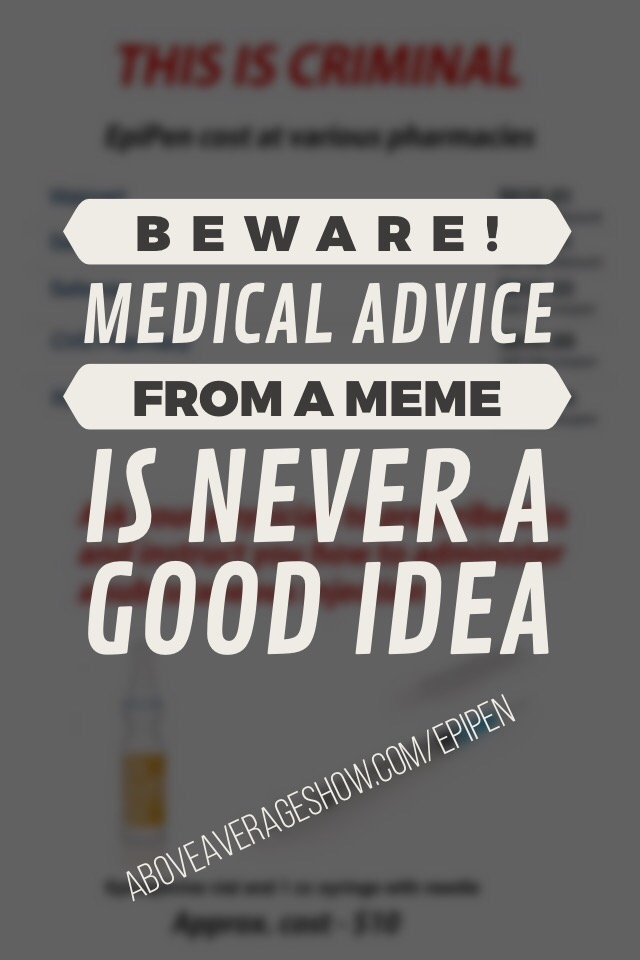EpiPen maker Mylan is in the middle of a firestorm from the media and general public for their recent and substantial price hike. As a medical professional, the crazy price for EpiPens is not news to me, and if you have a child with a severe allergy, it’s probably not new news to you, either.
But price aside, I wanted to take a minute to address a related issue here on the Above Average blog. (While we don’t have life-threatening allergies in our family, you may: bigger families are statistically more likely to have a kiddo who has a health issue like a food allergy!)
There are many ideas being tossed around for alternatives to the expensive EpiPen device, particularly one that suggests an ampule of epinephrine and a sub-q syringe is a cheaper, equivalent alternative. One way it’s going around is in this viral meme that has hit my Facebook wall numerous times:

Beware of this meme! Source unknown.
Beware!
Here’s why all of this can be dangerously wrong, even if the creator of the image had good intentions. While this information is technically accurate, it’s very impractical for the average person when someone’s life is on the line. There’s simply too much that could go wrong.
As a Pediatric Nurse Practitioner with several years of pediatric acute care experience before my MSN, and also as a mother of five kids, I have given a lot of medication to children for many different reasons, including injections in emergency situations.
Epinephrine is a drug you need in an emergent, anaphylactic event. It matters how fast the drug can be administered. Drawing up a medication like this in an emergent situation is not something I would recommend to anyone who does not do it frequently. Even then, if it is your child in danger, your mind is in a totally different place: it’s racing, and it’s almost impossible to keep your cool.
Food allergies are increasingly more common. According to Food Allergy Research and Education,
“Every 3 minutes, a food allergy reaction sends someone to the emergency department – that is more than 200,000 emergency department visits per year.”
This is not something to play around with.
Going back to the viral image, to draw up the medication, you would have to be of sound mind and not panic. Imagine how difficult this would be to do when a child’s life is on the line – and now imagine that child is your own.
You would need to correctly open the ampule, placing a tissue or a cloth around it and breaking it open away from you, and not spill it. Then you would need to use a filter needle to draw up the correct amount of medication with out any bubbles, cap that needle, and remove it. Next, you would replace the needle with the injection needle and then you must inject medication correctly through bare skin – not through clothing and not too deep or too shallow or in a vein. Then recap the needle so as not to have any accidental needle sticks. And finally, call 911 because the emergency may not be over.
For a video demonstration of how to draw up medication from an ampule take a look here, it’s not exactly quick:
(Reminder: This is included as an example of how complex this situation could be. I am heavily advising against this kind of thing for the general public.)
You also cannot draw it up in advance to save for later, like an EpiPen. And keep in mind this combination would be much less portable, as the risk for breaking the ampule or bending the needle riding around in your purse is very real. In addition, don’t forget that you would need to train (and trust) anyone who cares for your child to do this properly in a high stress situation. Oh, and they may also need to do all this a second time if the first time was not enough.
In contrast, administering an EpiPen or comparable device is much simpler: basically take the top off and “jab” it into the thigh. This is something even the patient (like an older child) could do themselves.
It’s also worth noting, with the auto-injector the medication is delivered intramuscular and has a much faster rate of absorption than the subcutaneous route suggested above. The EpiPen also allows for injection through clothes, even jeans.
Here’s a video that shows just how simple it is:
Point being: This is all information you should be getting from your child’s healthcare provider – doctor, nurse practitioner, or physician’s assistant -and your pharmacist. Do NOT assume that advice that has gone viral on social media is right just because it’s popular.
I’m not going to get into the politics or morality of prices of the EpiPen: it is a very expensive product, and the price justification (or lack thereof) will happen in other forums. I simply want to help keep kids healthy and their parents sane!
If this issue directly affects you, there are other auto-injectors on the market, they are just not as well known as Mylan’s EpiPen. Talk to your healthcare provider or your pharmacist and ask about your options!

Share or pin this image if you agree.
If you liked this post you may also be interested in these podcast episodes:
